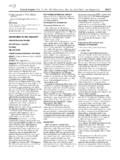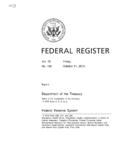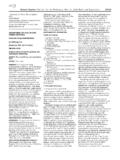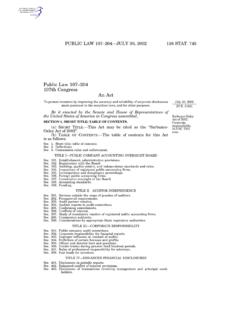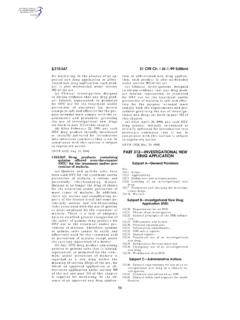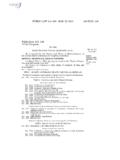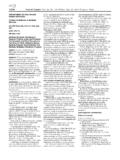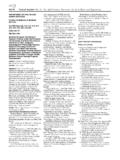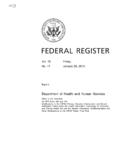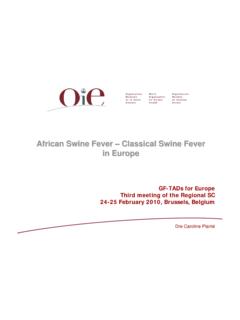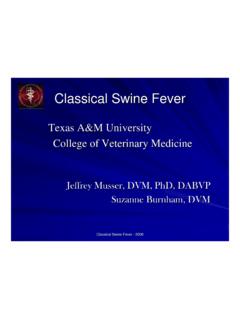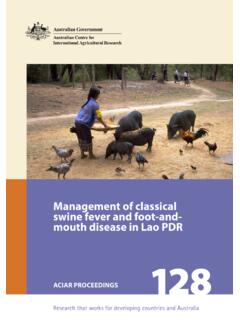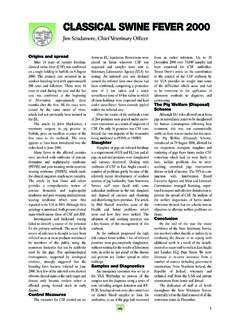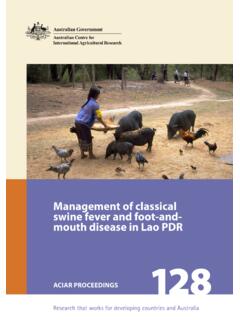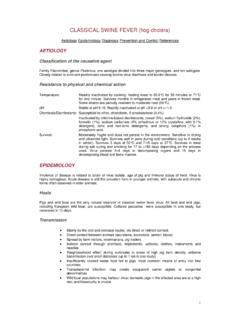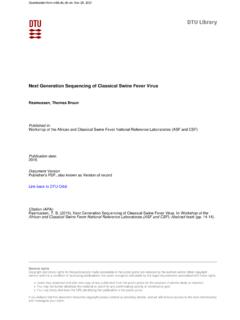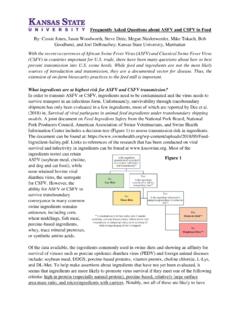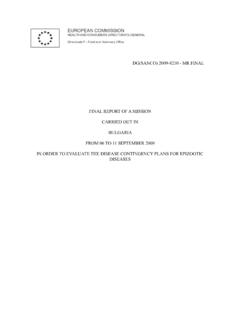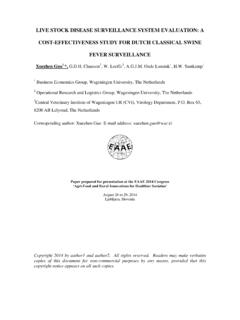Transcription of 17928 Proposed Rules Federal Register
1 This section of the Federal Register contains notices to the public of the proposedissuance of Rules and regulations. Thepurpose of these notices is to give interestedpersons an opportunity to participate in therule making prior to the adoption of the RulesFederal Register17928 Vol. 70, No. 67 Friday, April 8, 20051 Biological Risk Analysis: Risk assessment and management options for imports of swine and swine products from the European Union June 2, 1999. 2 Risk Analysis for Importation of classical swine fever Virus in swine and swine Products from the European Union December OF AGRICULTURE Animal and Plant Health Inspection Service 9 CFR Parts 93, 94, and 98 [Docket No. 02 046 1] RIN 0579 AB79 Importation of swine and swine Products From the European UnionAGENCY: Animal and Plant Health Inspection Service, : Proposed : We are proposing to amend the regulations for importing animals and animal products into the United States to apply a uniform set of importation requirements related to classical swine fever (CSF) to a region consisting of all of the 15 Member States of the European Union (EU) that comprised the EU as of April 30, 2004 (the EU 15) and prohibit for a specified period of time the importation of live swine and swine products from any area in the EU 15 that is identified by the veterinary authorities of the region as a restricted zone.
2 We believe these changes are necessary to help prevent the introduction of CSF into the United States while increasing our responsiveness to changes in the CSF situation in the : We will consider all comments that we receive on or before June 7, : You may submit comments by any of the following methods: EDOCKET: Go to to submit or view public comments, access the index listing of the contents of the official public docket, and to access those documents in the public docket that are available electronically. Once you have entered EDOCKET, click on the View Open APHIS Dockets link to locate this document. Postal Mail/Commercial Delivery: Please send four copies of your comment (an original and three copies) to Docket No. 02 046 1, Regulatory Analysis and Development, PPD, APHIS, Station 3C71, 4700 River Road Unit 118, Riverdale, MD 20737 1238. Please state that your comment refers to Docket No. 02 046 1. Federal eRulemaking Portal: Go to and follow the instructions for locating this docket and submitting comments.
3 Reading Room: You may read any comments that we receive on this docket in our reading room. The reading room is located in room 1141 of the USDA South Building, 14th Street and Independence Avenue SW., Washington, DC. Normal reading room hours are 8 to 4:30 , Monday through Friday, except holidays. To be sure someone is there to help you, please call (202) 690 2817 before coming. Other Information: You may view APHIS documents published in the Federal Register and related information on the Internet at FURTHER INFORMATION CONTACT: Dr. Chip Wells, Senior Staff Veterinarian, Regionalization Evaluation Services Staff, National Center for Import and Export, VS, APHIS, 4700 River Road Unit 38, Riverdale, MD 20737 1231; (301) 734 INFORMATION: Background The Animal and Plant Health Inspection Service (APHIS) of the United States Department of Agriculture (USDA or the Department) regulates the importation of animals and animal products into the United States to guard against the introduction of animal diseases not currently present or prevalent in this country.
4 The regulations in 9 CFR part 94 (referred to below as the regulations) prohibit or restrict the importation of specified animals and animal products to prevent the introduction into the United States of various animal diseases, including classical swine fever (CSF), rinderpest, foot-and-mouth disease, bovine spongiform encephalopathy, swine vesicular disease, and African swine fever . Sections and of the regulations state that CSF is known to exist in all regions of the world, except for those regions listed in (a) and (a). The importation of live swine and swine products from regions not recognized as free of CSF is restricted or prohibited. In addition, the importation of live swine and swine products from a region consisting of certain Member States and portions of Member States of the European Union (EU) is restricted with regard to CSF, even though that region is listed as free of the disease. The restrictions on imports from that region were established in a final rule published in the Federal Register on April 7, 2003 (68 FR 16922 16941, Docket No.)
5 98 090 5). We based our final rule primarily on two risk analyses conducted by risk analyses examined a region consisting of EU countries (Member States) that the European Commission (EC) asked us to recognize as free of CSF. (The EC is the EU institution responsible for representing the EU as a whole. It proposes legislation, policies, and programs of action and implements decisions of the EU Parliament and Council.) The Member States identified were Austria, Belgium, France, Germany, Greece, Italy, Luxembourg, the Netherlands, Portugal, and Spain. Five other EU Member States Denmark, Finland, the Republic of Ireland, Sweden, and the United Kingdom were already recognized by APHIS as being free of first risk analysis was made available to the public in 1999 at the time of publication in the Federal Register of the Proposed rule (64 FR 34155 34168, Docket No. 98 090 1) upon which we based our April 2003 final rule. The second risk analysis was released in 2002 for public comment (67 FR 22388 22389, Docket No.
6 98 090 2) and represented a revision and supplementation of the 1999 risk analysis. Data used in both risk analyses represented events that occurred during a CSF epidemic in Europe during 1997 and 1998. That outbreak is considered to be the most severe CSF epidemic ever experienced in Europe. Both risk analyses are available by calling or writing to the person listed in this VerDate jul<14>2003 15:28 Apr 07, 2005 Jkt 205001 PO 00000 Frm 00001 Fmt 4702 Sfmt 4702 E:\FR\FM\ 08 APP117929 Federal Register / Vol. 70, No. 67 / Friday, April 8, 2005 / Proposed Rules document under FOR FURTHER INFORMATION CONTACT. The analyses are also available on the Internet at At the bottom of that Web site page, click on Information previously submitted by Regions requesting export approval and supporting documentation. At the next screen, click on the triangle beside European Union/Not Specified/ classical swine fever , then click on the triangle beside Response by APHIS, which will reveal links to the risk analyses.
7 The analyses took into account, among other things, the CSF history of the EU region consisting of the 10 Member States in the EC s request, the CSF history of countries adjacent to the region, the veterinary infrastructure and policies of the region, and the historical volumes of imports into the United States of breeding swine , swine semen, and pork and pork products from the region. Based on the analyses, we considered it necessary to establish certain mitigation measures for the importation of live swine , pork and pork products, and swine semen from the region. Although there were no CSF outbreaks in EU domestic swine within the defined region at the time, the risk analyses assumed that, because CSF was endemic in wild boar in several parts of the EU, it was likely CSF would continue to occur in domestic swine in the region. Further, the risk analyses considered the open borders among EU Member States. To address these situations, the final rule required that commodities from the region of the EU that was considered to be unaffected with CSF be segregated from those from CSF-affected regions of the EU and other CSF-affected regions, and that measures be taken to ensure that donor boars providing semen for export to the United States are truly free of CSF.
8 These requirements are described below under the heading Importation Conditions Established in April 2003. Importation Conditions Established in April 2003 Specifically, our April 2003 final rule required that the following conditions be met before the commodity in question could be imported into the United States (in the absence of any other diseases of swine that would otherwise prohibit importation): For pork and pork products: (1) The articles have not been commingled with pork or pork products derived from swine that have been in a region listed at the time as one in which CSF is known to exist; (2) the swine from which the pork or pork products were derived have not lived in a region listed at the time as one in which CSF is known to exist, and have not transited such a region unless moved directly through the region in a sealed means of conveyance with the seal determined to be intact upon arrival at the point of destination.
9 And (3) the articles are accompanied by a certificate, issued by an official of the national government of the region of origin, stating that the above provisions have been met. For breeding swine : The swine (1) have never lived in a region listed at the time as one in which CSF is known to exist; (2) have never transited such a region unless moved directly through the region in a sealed means of conveyance with the seal determined to be intact upon arrival at the point of destination; and (3) have never been commingled with swine that have been in a region listed at the time as one in which CSF is known to exist. Additionally, no equipment or materials used in transporting the swine may have previously been used for transporting swine ineligible for export to the United States unless the equipment or materials first were cleaned and disinfected. Lastly, the swine have to be accompanied by a certificate, issued by a salaried veterinary officer of the national government of the country of origin, stating that the above provisions have been met.
10 For swine semen: The donor boar meets the same conditions as those listed above for breeding swine . Additionally, the following conditions must be met: (1) The semen comes from a semen collection center approved for export by the veterinary services of the national government of the country of origin; (2) the donor boar is held in isolation for at least 30 days prior to entering the semen collection center, and, no more than 30 days prior to being held in isolation, is tested with negative results using a CSF test approved by the Office International des Epizooties (OIE) [also referred to as the World Organisation of Animal Health]; and (3) the donor boar is observed by the semen collection center veterinarian while at the center (including at least a 40-day holding period at the center following collection of the semen) and, along with all other swine at the center, exhibits no clinical signs of CSF. Under these conditions, we estimated that the risk of introducing CSF through imports from the defined region would be as follows: By importing breeding swine , most likely one incursion in an average of 33,670 years.
